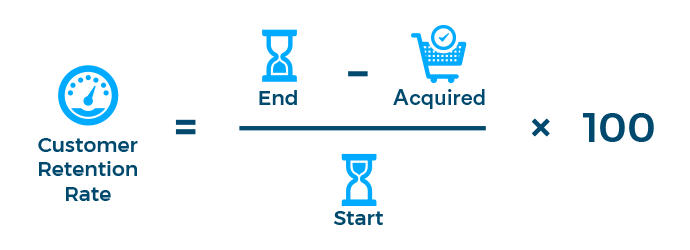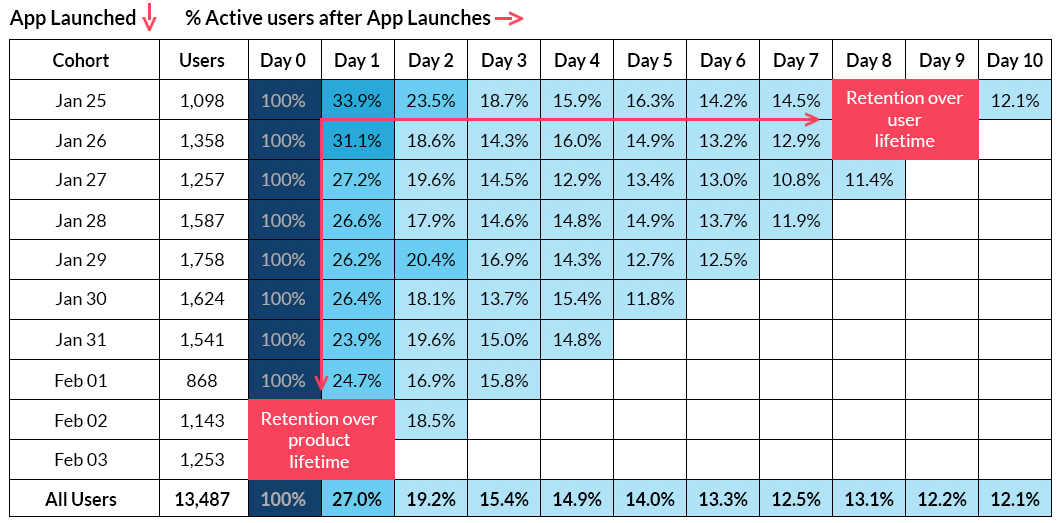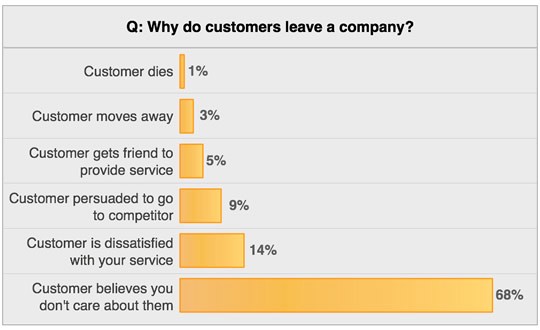“If you invest in growth before you have retention, you are renting users, not acquiring them.” — Tarun Mitra
The business-customer relationship is often compared to a real relationship, and it’s never more relevant than in the case of customer retention.
Viewing customers as separate entities encourages short-term decision-making.
“100 people have signed up. Next!”
But here’s the thing: the customer isn’t truly ‘acquired’ unless they’re in it for the long run. If not, they aren’t really our customers; they’re just strangers passing through.
Once we’ve ‘acquired’ a customer, we need to continue to ‘acquire’ them throughout their customer journey.
In this instance, ‘acquire’ stands for ‘impress them, delight them, show them they’re valued’. We need to keep looking for ways to do more for them than anyone else is doing.
Failing to prioritize customer retention is like trying to fill a bath without the plug in. Yes, you can keep the water running, but the bath won’t ever be full: you need to find the plug.
Acquiring new customers is expensive. Keeping existing ones isn’t.
In fact, a much-cited study by Harvard Business School found that it’s 5x — 25x more expensive to acquire a new customer than it is to retain an existing one.
Returning customers = return on investment.
A 5% increase in customer retention can increase company revenue by 25%-95%.
That’s because retained customers tend to be the happy, loyal ones that drive higher life-time value. The ones who understand the value of our product. The ones who refer us to their family and friends. The ones who spend more, more often.
But in the case of many startups — when time is scarce, and resources are tight — the need to develop and implement a customer retention strategy can plummet to the bottom of the to-do list.
And when customers aren’t sticking around (and when we don’t know why) it has a domino effect on our finances and business.
Ready to develop a retention strategy?
Before you begin, it’s helpful to know where you currently stand, retention-wise.
That’s where Customer Retention Rate (CRR) comes in.
CRR is the percentage of customers who stay vs. the number of customers who leave. It is, simply put, the rate at which we keep our customers.
To calculate your CRR, you’ll need to define a period over which you will measure; this could be monthly, quarterly or annually. Then, work out the value of the following:
| 1. | Number of customers (S) at the start of a period |
|---|---|
| 2. | Number of new customers (N) acquired during that period |
| 3. | Number of customers (E) at the end of that period |
Once you’ve got those figures, you plug them into this little formula:
Customer Retention Rate = ((E-N)/S) x 100
Here’s an example:
We start the month with 100 customers. At the end of the month, we have 105. We have lost 15 customers and acquired 20.
((105–20)/100)) X 100 = 85%
So, 85% of our customers are continuing to use our service, giving us a CRR of 85%.
CRR is a great place to start. If we want to dig deeper into the matter, there are a couple of other metrics worth looking at.
Cohort analysis
A cohort analysis is a set of behavioral analytics that takes user data and breaks it down into groups.
It can be used to measure user retention over a period of time, helping us to understand whether retention is actually improving or just appearing to because of growth.
Rather than looking at users as one unit, it breaks them into related groups.
The dreaded churn
The arch nemesis of retention: churn. It’s worrying when your stomach does a lot of churning, and it’s even worse when your customers do.
Churn happens when customers leave.
It is the detractor to your CRR, the de-accelerator to your growth, the yin and yang of startups: 50% churn = 50% retention, 30% churn = 70% retention, and so on.
Similarly to CRR, churn rate needs to be calculated over a specific period.
Churn rate = the number of customers you lost over the period ÷ the number you had at the start of the period.
Pretty straightforward. However, in the case of many subscription businesses, not all customers — and therefore losses — are created equal.
If you lose a free plan customer, that sucks. If you lose a customer who’s paying $200 per month, that sucks more.
With that in mind, it’s handy to consider revenue churn rate, too.
Revenue churn rate = revenue lost over the period ÷ revenue at the start of the period.
‘We get it,’ you’re probably thinking. ‘Retention is good, churn is bad’.
Yes. So what we need to know is:
What’s making people stay, and what’s making them leave?
To stop users leaving, we need to know why they’re leaving us.
Luckily, there are plenty of ways to find out.
1. Start by asking: Conduct an NPS® or CSAT survey
In one of my recent guides, I explained all the key metrics to measure customer happiness and highlighted Net Promoter Score (NPS) & Customer Satisfaction (CSAT) as the two metrics that are widely used by founders.
Those customer metrics help you to find out who’s scoring low, and why.
- You can set up an NPS form using a ready-to-use NPS template or build it from scratch on a free form builder.
- To measure CSAT, you can get started with a simple template, or focus on measuring multiple touchpoints using a more complex template as well.
2. Pinpoint the problem
Bugs, lack of information, incorrect billing, missing features…? All valid churn-triggers.
Make note of customer feedback to work out the most common problem(s). Then you can stagger your customer team’s efforts accordingly.
It’s important to make it easy for users to report issues. You can add a simple feedback button on your website or set up a customer support form here.
3. Analyze
Look into periods of user activity vs. inactivity, changes in plans, cancellations… It’s useful to visualize these interactions to highlight comparisons and context more effectively.
4. Test the waters
Organise a test with groups of customers who haven’t used your product before, and evaluate their responses.
5. Conduct an inside job
Often our most surprising customer insights emerge closest to home. It’s not just the customer support team who might have ideas on why people aren’t sticking around. Schedule a regular internal feedback session with all staff to understand if there are any blind spots you might be missing.
6. Have a reality check
One of the biggest drivers of customer dissatisfaction is disappointment caused by unmet expectations. Evaluate your product/service/insert where relevant: are you over-promising and under-delivering anywhere?
And remember….
The main and most important reason customers leave is because of ‘perceived indifference’.
Timing is key
Unless something has gone horribly wrong, most customers won’t make a snap decision to leave a company.
Usually, they stop using the product over time: once a day, to once a week, to once a month, to never. Then, the account will probably remain active for a while without any activity.
Six months later, the customer will receive a marketing email and remember to cancel their account. Boom! Churn alert. Cue lots of companies sending ‘Please, don’t leave us’ emails to try and change the customer’s mind.
By then it’s too late: the decision was made months ago. The customer has probably already signed up for a different service, too. No dice.
It’s important to try and address churn as early on in the process as possible. This means analyzing drops in activity sooner rather than later, and trying to re-engage customers at the first sign of cracks showing.
What’s next?
So, you’ve analysed. You’ve asked. You’ve listened. Now it’s time to come up with a strategy to increase retention and reduce churn.
As I outlined before, the best way to engage customers is through genuine conversation.
Here are some tips to get you started.
1. Segment carefully, customise accordingly
Last week’s subscriber not choosing to upgrade is going to require a different retention tactic than a three-year veteran who wants to leave. Avoid the cliche’ ‘we miss you/how could you leave us?’ guilt-trip.
The more personalized a user’s experience is, the better. Using a CRM tool is helpful to store user information notes from meetings and phone calls, ongoing issues, personal preferences of the customers, etc.
2. Deliver EXTREME value
Added value is one of the most powerful ways to boost customer retention.
- Launching a side project is a great way to give something valuable away for free in order to sell something related. It helps you to re-engage users by offering extreme value in one place — with no extra effort on their part.
- Sharing knowledge for free shows your users that you care. You don’t need to be a teacher, you just need good ideas. Providing educational material via your blog, knowledge centre, webinars etc., will improve the customer’s experience and reduce issue tickets.
- Creating a customer loyalty program will encourage users to stick with you over competitors. Reward them with points, offers, incentives — whatever suits you. People love feeling like they’re part of a club.
3. Set expectations — if you can meet them.
Disappointment happens when expectations exceed reality. It can be tempting to promise you will address issues straight away, but if you can’t meet these expectations, it’s better to say nothing at all than to let people down.
4. Always be launching
Customers stop using a product because they no longer see any value in it for them. They need a reason to stay. By offering customers who are slipping away a glimpse of exciting new releases — instead of just begging them not leave — you can entice them back in without the desperate undertone.
5. Get visual
Screenshots or diagrams of new features often have far more impact than plain paragraphs of text. An overload of content can suffocate your message, too, so make campaigns simple and slick.
Incorporating gamification into your offering is another tactic that pays off; you can encourage users to complete tasks and actions by adding a fun or competitive element.
We’ve jumped on the bandwagon at Jotform with our interactive Cards, a super-responsive update on static forms that feature micro-animations and motivational gamification effects.
6. Offer 24/7 support
Today’s customers expect immediacy. Making them wait around for a response will have them running for the hills. You can ensure your users get a quick response by setting up a live chat using a tool like Intercom.
7. Communicate results
Customers are more likely to stay with your company if they are aware of the results and ROI you deliver. If you can regularly communicate the payoff of your product, users won’t forget its value.
8. Use reciprocity
Acts of kindness make people want to repay them: that’s why reciprocity creates retention. Surprise emails, personalized thank you notes, unexpected incentives — small touches like these can have a big impact.
9. Leverage momentum
When your product is undergoing exciting changes, people in your company will know about it, but your customers might not. Keep your customers updated on improvements, new features and updates, and demonstrate new ways they can use your product and get added value from it.
Don’t forget
Especially in the early days of a startup, there will be customers for who your product just isn’t the right fit — and that’s perfectly normal. It doesn’t mean anything needs to be ‘fixed’.
When a customer does decide to leave, remember the relationship metaphor. Don’t fight back; set them free, and try to stay friends (so no pushy follow-up emails or calls).
These tactics shouldn’t be confused with shortcuts. A personal relationship can’t be built overnight, and business-to-customer relationships are no different.
At the end of the day, it’s our product and service that will be the biggest long-term drivers of loyalty. And they can’t be hacked.
Net Promoter®, NPS®, NPS Prism®, and the NPS-related emoticons are registered trademarks of Bain & Company, Inc., NICE Systems, Inc., and Fred Reichheld. Net Promoter ScoreSM and Net Promoter SystemSM are service marks of Bain & Company, Inc., NICE Systems, Inc., and Fred Reichheld.























Send Comment:
1 Comments:
More than a year ago
I like the focus on customer support and reciprocity. It is very difficult at times to convince users that you are genuinely offering support as opposed to having a bot sitting there giving answers. Do you often get that question to your support team?